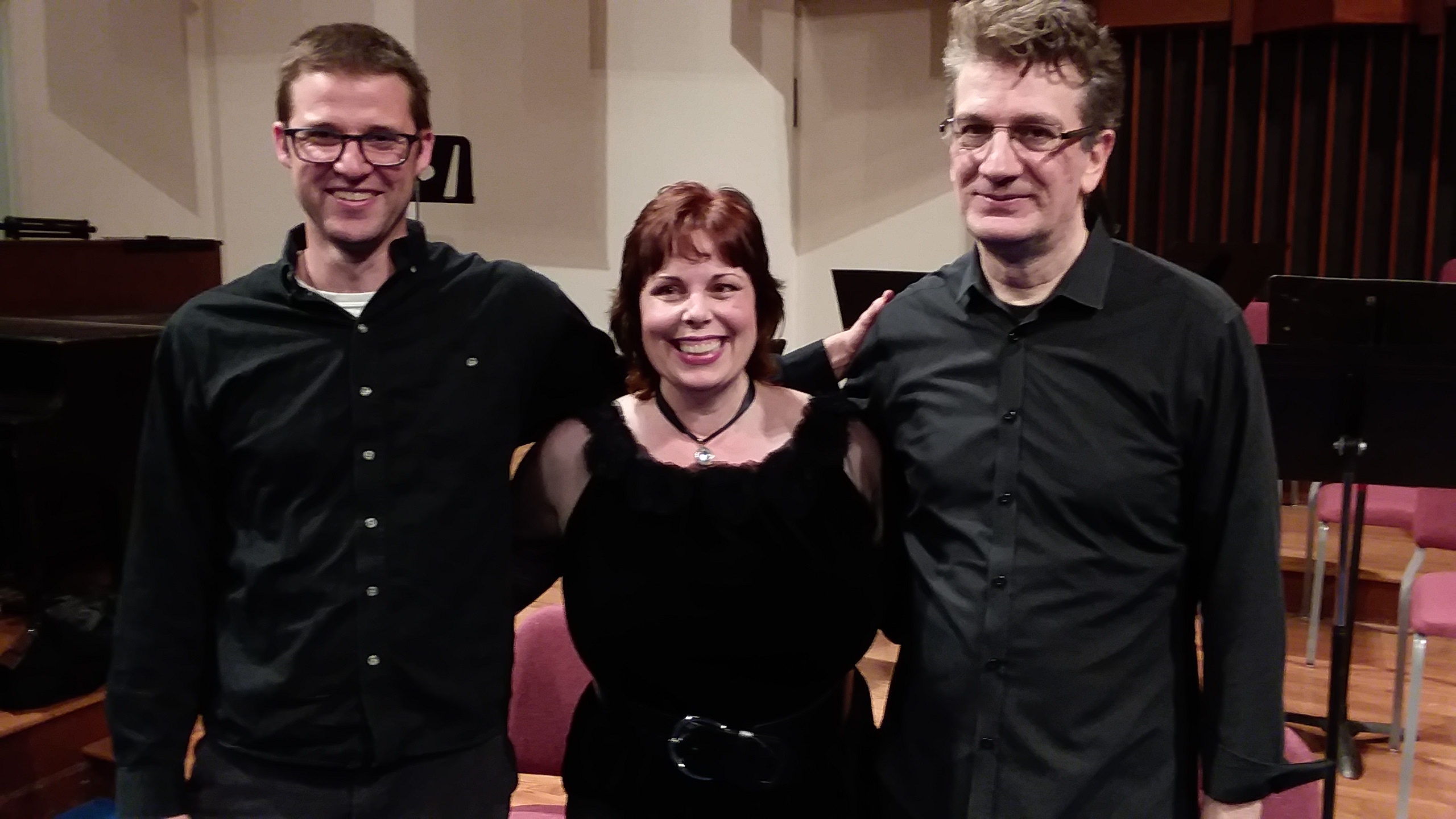ECHO Chamber Orchestra's ambitious season opener (2019)
L to R: Kevin Gordon, Wendy Loder, Daniel Canosa. Photo by Abby Wasserman.
ECHO CHAMBER ORCHESTRA OPENS NEW SEASON
By Abby Wasserman
For its 2019-2020 season opener on September 22, ECHO Chamber Orchestra, under the direction of Daniel Canosa, chose an ambitious program of four works ranging from 1815 to the very present. Performed in the graceful, high-vaulted First Presbyterian Church of San Anselmo, the concert engaged rapt attention from start to finish from the audience of 70. ECHO, which presents a single performance of each program and draws between 25 and 52 musicians from the Bay Area and beyond, is a collaborative group well fitted to the chamber experience, and the ensemble’s musical scope is far reaching.
The evening began with one movement of Louise Ferranc’s Nonet in E-flat major, Op. 38 (1849). Scored for violin, viola, clarinet, oboe, French horn, bassoon, double bass, cello and flute, it was performed leaderless, and its cohesion depended on the musicians listening closely to one another. Ferranc (1804-1875) was a celebrated pianist and the first femme to have a professorship at the Paris Conservatory, where she taught for 30 years. Her Nonet’s first movement, Adagio-Allegro, is a sprightly introduction to the full work, transparent and charming, with solo parts for each of the nine instruments. The group could have used more rehearsal time, and there was some struggling here and there with tempi and pitch problems from the violinist. The ensemble sections were well done, and the winds and brass in particular accomplished their solos with precision and panache.
From France the musical tide flowed to Russia: Rachmaninoff’s exquisite Vocalise, Op. 34, No. 14, for Soprano and Orchestra (1912), originally composed for soprano or tenor and piano. Soprano Wendy Loder, who is also the orchestra’s concertmaster, was the soloist. Her wide vibrato—the word “warble” comes to mind—soared from note to note on a single vowel (ah). The piece has the hypnotic quality of Debussy’s Sirènes and the depth of Prokofiev’s “The Field of the Dead” from his cantata Alexander Nevsky. Mr. Canosa held the orchestra in check so that they never overwhelmed her. Each vocalist in this wordless song must choose the story to tell; to some, it is a narrative of grief, hope and resolution. Ms. Loder chose to accentuate the sustained, lilting musical line. The audience did hold their applause for a brief moment, but the performance begged a meditative silence.
Prior to Vocalise, Mr. Canosa and double bassist Kevin Gordon came onstage to provide verbal notes for the world premiere of their collaborative composition, City Suite. It was inspired by their individual impressions of four cities and their collective impressions of a fifth. The form of each, they said, relates to the dances in suites by Bach. There were no program notes, unfortunately, but it was nice to have the live explanation about their process. For his part, Mr. Canosa selected Amsterdam and Buenos Aires, the city of his birth. Mr. Gordon chose San Francisco and New York, and the two collaborated on Paris.
Each movement except “Buenos Aires” had a subtitle of a dance found in Bach suites: “Amsterdam” was in prelude form; “San Francisco” a bourée; ”Paris” an allemande morphing into the tango rhythms of “Buenos Aires,” and “New York,” a gigue. But in no other way does City Suite remind one of the Baroque period. It positively cascades with visceral sense impressions. “Amsterdam,” the first and most dissonant of the movements, evokes city bustle, church bells, the changing blue light of high latitude summer skies, and rhythmic, pulsing bursts (a guest percussionist joined the orchestra’s resident percussionist/tympanist). “San Francisco” blended hippie, funk and fog with high tech. “Paris” incorporated a medieval chant, which the multitalented Ms. Loder rose from her violinist’s chair to sing in Latin about the call of the god of love, then swept attacca, without pause, into the tango rhythms of “Buenos Aires.” The last movement, Mr. Gordon’s “New York,” brought the work to an exciting climax with jazzy flair.
Flowers were presented to Mr. Canosa, Ms. Loder and Mr. Gordon, and then, laying his on the floor, with true ECHO informality the conductor simply turned to the audience and said, “Now we’ll do the Schubert.”
The Schubert was Symphony No. 3 in D major, composed in the summer of 1815, a few months after the composer’s 18th birthday. Like the rest of his first six symphonies, it wasn’t published during his lifetime. The first movement, Adagio maestroso—Allegro con brio, begins with drama but moves quickly into Haydnesque ebullience. The second movement, Menuetto: Vivace, evoked Mozart, and the third, Presto vivace, was Rossini-like—almost operatic. Despite those associations, this was all Schubert, full of bold experimentation and lovely melodies. The orchestra performed with skill and gusto, and the audience responded enthusiastically. The concert was followed by a reception in the social hall, complete with wine, refreshments, and an art show.
Originally published at classicalsonoma.org
Photo of (from left) Kevin Gordon, Wendy Loder and Daniel Canosa by Abby Wasserman
